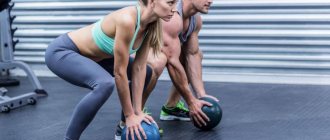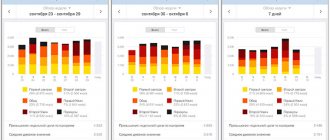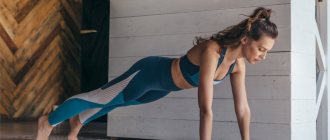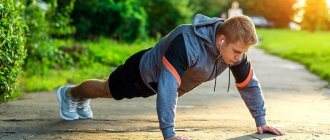Every lady once a month goes through a number of unpleasant sensations that are provoked by the menstrual cycle. This includes abdominal cramps, heaviness, discomfort, and weakness of the body. The weaker sex faces restrictions during the “red” day in the calendar. Women who go to the gym or work out at home deprive themselves of this pleasure for several days. Is it possible to pump up the abs during menstruation and perform other exercises?
Some people feel great during the menstrual cycle and are not ready to give up physical activity; for other ladies, “critical” days pass painfully and it is difficult to do anything during this time, even if desired. But, it’s worth looking at why you can’t pump up your abs during your period or play sports in general.
Are sports allowed?
Is it possible to pump up your abs while on your period? It all depends on how the girl feels. If there is no abdominal pain or discomfort, then you can engage in physical activity. If you feel very bad and don’t even know how to survive these 7 days, not to mention sports, then you shouldn’t mock your own body. It’s better to rest, lie on the couch more, otherwise you won’t get any results from sports other than pain and discomfort. 100% contraindications to physical activity during the menstrual cycle include the following factors:
1. The attending doctor prohibits you from doing exercises due to health difficulties.
2. “Holidays” are accompanied by terrible painful sensations, dizziness, fatigue, heavy discharge, lasting more than 7 days.
3. If there are certain gynecological problems for which it is not worth risking your health.
If the above symptoms are absent, then you can pump up your abs during your period without worrying about anything. This is not only not prohibited, but can also have a satisfactory effect on the course of the menstrual cycle. In this case, there is no need to prohibit playing sports.
Is it possible to exercise while on your period?
There is a two-fold opinion of experts on this matter:
FOR TRAINING:
- Physical activity increases blood circulation, supplying muscle tissue with oxygen and other important nutrients, while at the same time it improves metabolism, as a result of which the state of lethargy of the body goes away a little and the feeling of discomfort decreases.
CONS: TRAINING:
- In this direction, the main argument is the well-being of the female body; it is better to stop training if the following factors are present:
- nausea and dizziness
- severe pain with a feeling of tightness in the lower abdomen
- excessive bleeding
- poor health and due to a complete lack of mood
- a ban from the gynecologist to use physical activity
- it is advisable to exclude physical activity on the first day of the onset of menstruation
Safe Exercises During KD
If there are no contraindications, you feel great, it’s worth doing abs during your period. It won't do any harm. But you should limit your activities to those physical activities that will not cause harm during this period of time. Safe ones include:
1. Basic training for the abdominal muscles. Move to a horizontal position, bend your legs at the knees, put your hands under your head. Then you lift your upper body, due to which you can effectively pump up your upper abs. There is no need to overexert yourself; you need to lift your shoulder blades from the surface.
2. No load on the torso. You will need to take a lying position, bending your knees and touching your feet with your fingers.
3. Working out the oblique muscles. Here you also need to position yourself horizontally, raising your torso, touching your left elbow to your right knee, and vice versa.
Such exercises will not harm a woman, even on the “red” days of the calendar. On the contrary, they minimize pain and discomfort, improve the general physical condition, and have a beneficial effect on the lady’s health. Therefore, when women ask trainers why they can’t pump up their abs during menstruation, most of them are perplexed. There are a lot of exercises that will not affect the condition of girls in these unpleasant days.
What kind of workout should you do during menstruation?
Moderate aerobic exercise is best for the menstrual period. For example, walking, light jogging or yoga and Pilates classes. In general, physical activity activates blood circulation, reduces painful spasms, improves the functioning of the digestive tract and contributes to more comfortable well-being during menstrual bleeding.
Photo: istockphoto.com
In addition, physical exercise stimulates the body’s production of joy hormones – endorphins, which means it helps lift your mood. However, on days of heavy discharge, it is necessary to exclude exercises associated with an increase in intra-abdominal pressure (to strengthen the abdominal press, leg press, etc.). The fact is that this can provoke a reverse flow of blood and endometrial tissue particles from the uterine cavity into the fallopian tubes and through them - into the abdominal cavity. That is, the risk of developing endometriosis increases in women who are prone to this disease due to genetic characteristics.
Total relaxation: how to relax after a workout
Recommendations for playing sports during critical days
People who cannot live a day without physical activity know how best to train during the menstrual cycle and give recommendations to beginners:
1. Play sports if there is no discomfort. Keep a personal calendar where you mark the days of your menstruation. If the cycle has not gone astray, everything goes according to plan and there are no deviations, then there are no contraindications. During training, also monitor the condition of your body.
2. Train carefully. This applies to the first few days of the cycle, so that the period of menstruation does not increase.
3. For the first few days, it is better to stick to light cardio. This will remove excess moisture from the body and will not overload it.
4. During your period, it is better to train your upper body. If you prefer strength training, try to combine it with cardio on critical days. Walk on a treadmill, exercise at a moderate pace on the orbit track.
5. You should not engage in grueling, exhausting workouts. During your period, choose short-term activities.
General points
Is it possible to work out in the gym while on your period? Here it must be said that every woman experiences menstruation differently. Some girls feel only a slight malaise and mild pain in the lower abdomen. For some, these days pass very quickly (in about three days) and are completely painless. And there are categories of women for whom, during menstruation, it is even difficult to get up from the couch for five or seven days.
In such a situation, a girl must decide for herself whether to go to the gym for training or not, based on her own feelings and well-being.
Additional recommendations
If during your period you experience discomfort and heaviness in your body, do not exercise in the gym; it is better to choose yoga at home. Yoga is an excellent option that will help eliminate discomfort in the body and cope with pain.
Regarding the press, everything is described in detail above, so you can safely pump it up if there are no unpleasant sensations or contraindications. But it is better to avoid other stress on the abs, meaning swimming. If you go to the pool regularly, it is better to refuse such pleasure during the exercise session. Firstly, while swimming your abs become tense, and secondly, the risk of getting some kind of infection increases. If you do not heed this advice, try to monitor your body condition while swimming, as soon as you feel tired, stop the activity.
It is strictly forbidden to squat and jump during the CD. It is better to choose simple exercises for the upper abs.
“Listen” to your body. If you feel great, train as usual, don’t change anything.
Important
Still, are training and periods compatible? The answer will be positive, but it is best to refrain from strength training. Moreover, you should not pump up your abs or do certain exercises that involve the abdominal muscles. This can increase menstrual pain.
The most important thing I wanted to say here is that menstruation is not a disease, but a natural state of any healthy woman. Therefore, if a girl feels well, then she can go to the gym and continue training.
Useful asanas during menstruation
To ensure that yoga during menstruation brings benefits and not harm or discomfort, you can select special asanas. For example, abdominal pain in the first days of menstruation is often associated with cervical spasm during uterine contractions. Poses of a tied angle, fish, and lying down help to get rid of pain and relieve tone. It is better to perform them on something soft, for example, a folded blanket, in order to maintain the asana for the required time and completely relax.
By performing the “cat-cow” movements, you can increase the tone of the uterus to improve the process of endometrial removal. This exercise tightens the ligaments that hold the uterus, and in response it begins to actively contract. But it is important to focus not on rounding the back or arching, but on moving the pelvis.
Postures that involve pulling the thigh toward the body increase intra-abdominal pressure and also improve the release of the endometrium. But bending from a standing position is not included in their number.
There are several asanas that are recommended to be performed during menstruation, but only if your health allows:
- Child's Pose (Balasana) is an asana for relaxation that helps get rid of emotional stress. You need to breathe slowly, deeply, directing your attention to the pelvic area. When lifting, inhale, the tailbone is pulled down, the groin and stomach are not tense. This pose is suitable even for beginners;
- Bend to the feet in a sitting position (Paschimottanasana) - improves the digestion process and posture, calms the nervous system. The main goal is to stretch the spine as much as possible, and not to sink as low as possible. In this position you need to stay for 5-7 breaths, at the exit the body rises upward gradually, vertebra by vertebra, starting from the lower back;
- Head on the knee (Janu Sirsasana) is a calming pose that helps normalize discharge and relieves abdominal cramps. In this asana, it is important to stretch the spine well without rounding the back, the shoulders should be parallel to the floor;
- Fish pose (Matsyasana) – relieves fatigue, discomfort associated with menstruation, stimulates the endocrine system, restores vitality. The asana also stimulates the functioning of the abdominal organs, helps fight bloating, gas, and dyspepsia;
- Lying butterfly pose (Supta Baddha Konasana) – has a calming effect. You need to come out of this asana using your hands, bringing your knees together. To reduce pressure on the pelvic area and uterus, you can place a thick pillow or folded blanket along your back.
Pranayama helps to achieve emotional balance during menstruation. No less useful are mantras and meditation, which promote relaxation and improve your mood.
How to structure training correctly?
It is worth considering the cycle when playing sports. Monitor every workout and load. If a woman does not feel well during her period, it is better not to go to classes. Exercises should be flexible. Build the training for yourself, not the other way around. A healthy lifestyle, fitness, training, physical activity are all good. But it’s better to think about your health, it’s better not to joke with it, and refuse such stress.
To begin with, you must prescribe your own workouts. It’s easy to carry them out and listen to how you feel. This is important in the first days of menstruation, when they are very heavy.
Also, the load should be increased gradually, and not immediately. This will have a good effect on a woman’s body, her reproductive system and hormonal levels. When your workouts happen once a week, and you give it your all, then a breakdown in the cycle is guaranteed. From this we conclude that you need to exercise in moderation, as well as eat right.
If your period has not arrived, then you are pregnant.
No, not necessarily. If you are healthy and sexually active, then the likelihood of pregnancy is, of course, very high. But there are other reasons for delay: hormonal imbalances, stress due to travel, time zone changes. There are problems due to lack of nutrients. In excessively thin girls, periods may simply stop.
If your cycle varies from month to month, and you are not 14 years old, you need to go to a gynecologist. We need to look for the reason for such disgrace.
FREE CONSULTATION WITH A DOCTOR
Phase II (6-13 days of the cycle)
In the second phase, the level of testosterone and estrogen in the blood begins to increase, metabolism accelerates and the functioning of the cardiovascular system improves. Efficiency and endurance increase, the woman feels a surge of energy. It also becomes easier to control your appetite and cravings for sweets.
Photo by: Bruce Mars
This period is the most favorable for effective sports. You can go to intensive classes, work with weights and weights, do cardio and interval training.
Nuances
I would also like to say a few words about when training and menstruation are not compatible with each other. This happens if a woman feels cramping pain in the lower abdomen, and at the same time it constantly intensifies with any movement. In such a situation, you should not go to extremes and it is necessary to reschedule classes for several days until the girl’s condition improves.
However, even in this case, you should not spend the entire day in bed in a supine position. Many gynecologists say that to reduce and even relieve pain, you need to move more and take walks in the fresh air. This will help lift a woman's mood during menstruation.
If the pain seems unbearable to a woman, then you can take a painkiller. But this is done only in the most extreme cases.
If a woman’s health is normal and nothing hurts, then she needs to pack her bag with her gym uniform and go to training. But it’s not worth overexerting too much. This must be remembered.
The longer a woman's cycle, the later menopause will occur.
Unfortunately or fortunately, there is no direct relationship.
A woman's menopause occurs when nature intended. This is influenced, firstly, by genetics, and secondly, by environmental factors. Perhaps you live in a metropolis with a so-so environment. Or, conversely, in a small town in a clean region. It also depends on whether the woman has had any abdominal surgery or illness. Whether she gave birth or not. It is generally accepted that a woman’s body produces about 400 fully formed eggs during her life. You can try to count, of course. But the egg does not mature in every cycle. And sometimes two of them ripen at once. Therefore, calculations are useless. Better play sports and come to menopause in good shape.
How to reduce pain
Even in the absence of pathologies, it is useful to know how to reduce pain during menstruation. After all, by following a number of simple recommendations, you can significantly reduce discomfort. If your lower back and stomach hurt before your period, you should:
- reduce the amount of stress;
- exclude heavy foods and foods that cause fermentation in the stomach;
- give up alcohol and smoking;
- maintain a good sleep schedule;
- diversify your diet with foods rich in calcium, magnesium, vitamins B and E;
- add moderate physical activity (yoga, gymnastics, etc.)
If you are taking contraceptives?
Oral or hormonal contraceptive drugs contain progesterone and estrogen. Women who take such contraceptives are not subject to changes in hormonal levels, since estrogen levels do not decrease so as not to stimulate menstruation and the onset of ovulation.
Progesterone and estrogen remain at stable levels rather than changing. When you stop taking contraceptives, your hormones begin to drop sharply. Women who use contraception can exercise during menstruation, focusing on their own well-being. Some continue to feel a surge of strength, while others, on the contrary, have no motivation and quickly get tired.
It should be understood that stable hormonal levels can promote both muscle gain and weight loss, since there are no fluctuations. Hormonal contraceptives do not affect the effectiveness of physical activity, but may increase insulin sensitivity.
Training these days! To study or not?
Delayed menstruation due to sports
Girls who decide to suddenly change their lifestyle and start playing sports may experience delays in the first months. You shouldn’t be afraid of changes, because the body is being rebuilt.
Sharply increased physical activity requires a redistribution of calories, which are also necessary to maintain a regular menstrual cycle. To prevent delays, the intensity of training must be increased gradually. Is it possible to exercise during menstruation? To prevent menstrual irregularities, it is necessary to limit the load.
Symptoms of pelvic floor muscle dysfunction
- Uncontrollable leakage of urine when exercising, laughing, coughing or sneezing (stress incontinence).
- The need to go to the toilet frequently or urgently (urge incontinence).
- Incontinence of gases and intestinal contents.
- Difficulty emptying your bladder or bowels.
- Prolapse of internal organs. In women, it is felt as a bulge in the vagina or a feeling of discomfort or heaviness. In men, there is a bulge in the rectum or a desire to empty the bladder, although there is no objective need for this.
- Pain in the bladder, bowel, or back near the pelvic floor when doing pelvic floor exercises or during sexual intercourse.
Experts emphasize that the above problems are not necessarily associated with weakness of the pelvic floor muscles, so their cause should certainly be found out. Diagnosis is carried out using electromyography, ultrasound or MRI.
Nutrition and training in different phases of the cycle
Proper nutrition during menstruation can reduce painful and unpleasant symptoms. During other phases of the cycle, it is also important to eat right in order to feel great and not suffer from hormonal changes.
Please note that the level of strength and energy changes with each phase of the cycle, and therefore the training regimen will also have to be optimized in accordance with hormonal levels.
Phases of the menstrual cycle
During different phases of the menstrual cycle, the body may behave differently. This is due to changes in hormonal levels during the period of maturation and release of the egg. Women's well-being may depend on the day of the month, which should be taken into account when planning training.
There are four phases of the menstrual cycle:
- Menstrual phase (1-4 days). This is the first phase when the endometrium of the uterus is shed if the egg has not been fertilized
- Follicular phase (5-11 days). This is the second phase (also called postmenstrual or estrogenic), during which new follicles mature in the ovaries.
- Ovulatory phase (12-15 days). This is the third phase, during which a mature egg is released and the corpus luteum (temporary secretory gland) is formed, producing progesterone under the influence of which the uterus begins to prepare for possible pregnancy and implantation of a fertilized egg.
- Luteal phase (16-24 days). This is the fourth (also called postovulatory or progesterone), when the corpus luteum dies if fertilization does not occur and decreases in size. Rejection processes begin in the endometrium, which lead to a new menstrual cycle.
- Premenstrual phase (24-28 days). The fifth phase, or PMS, known to many girls, can also be attributed to the final stage of the luteal phase. The premenstrual phase is accompanied by a decrease in the concentration of estrogen and progesterone in the blood, a decrease in performance and an increase in the excitability of the nervous system.
The days of each phase are indicated based on a 28-day cycle; they may be different for you.
Training in different phases of the menstrual cycle
During each phase of the cycle, a woman's body experiences a different composition of hormones, which leads to changes in well-being, energy levels, and even appearance. For example, rampant estrogen during the ovulatory phase enhances attractiveness, femininity and charm.
Menstrual phase
During the first phase of your cycle, your body's progesterone and estrogen levels are low, which can cause you to feel tired. This is the time of menstruation, which women experience differently. If you feel unwell at this time, it is recommended to refrain from training and instead prefer a walk in the fresh air. Light cardio, yoga, strength training with light weights is acceptable, provided there are no painful symptoms.
Follicular phase
During the follicular phase, estrogen (the main hormone for women's health) gradually increases, affecting energy and libido. At this time, you can safely engage in the most difficult and dynamic workouts, as the body is at the peak of strength and endurance. Master new directions, train for weight loss and fat burning, at this time you can achieve impressive results.
Ovulatory phase
The ovulatory phase lasts only 3-4 days. During this period, the egg matures and the corpus luteum forms, which can lead to minor pain in the lower abdomen. During the ovulatory phase, it is not recommended to pump the abs, squat with heavy weights, or do deadlifts, so as not to increase the pressure inside the abdominal cavity. During the ovulatory phase, the amount of estrogen, which is responsible for energy and excellent well-being in women, reaches a peak and then decreases, so you may feel a loss of strength for physical activity.
Luteal phase
The luteal phase is characterized by a decrease in estrogen, but an increase in progesterone, which leads to unstable emotional well-being and internal devastation. Strength becomes less, especially in the second half of the luteal phase, when estrogen, progesterone and testosterone drop sharply. This period is called PMS. During the first half of the luteal phase, you can train as usual, but the most effective will be slow and measured strength training, supplemented with short, moderate-intensity cardio.
Premenstrual phase
During PMS, the body begins to retain water, irritability, sleep disturbances, increased appetite and cravings for sweets appear. During this time, exercise will help significantly relieve PMS symptoms, as it increases serotonin levels, which have decreased due to decreased estrogen. Also, exercising in the gym or outdoors helps remove excess fluid, achieve emotional balance and relaxation. Work out as usual, but you can focus on cardio to stimulate fluid removal and increase endorphins in the blood.
By training in accordance with hormonal changes, you will be able to achieve greater results, since you will know when the body is at its peak of energy and when there is not enough strength at all. Create a training schedule based on your cycle and achieve better results.
Nutrition during different phases of the menstrual cycle
Changes in hormonal levels lead to changes in weight, which are caused by a decrease or increase in appetite in different phases of the cycle.
Menstrual phase
In the nutrition plan during menstruation, at the very beginning of the cycle, it is recommended to include foods rich in iron: meat, legumes, seafood, nuts, dark berries, pomegranate and pomegranate juice, buckwheat, apples, wild rice. You should not eat cold foods, such as yogurt or ice cream, as they can cause painful cramps. At this time, weight begins to return to normal after a slight increase during PMS, but the waist will still appear larger due to the enlargement of the uterus and water retention in the body.
Include foods that contain tryptophan in your diet during your period to feel calm and confident, and to sleep better.
Follicular phase
During the follicular phase, metabolism is at its highest level, and appetite is stable and moderate. You can afford almost everything without harming your figure. To not only feel good, but also look like a millionaire, eat more vegetables, fruits, and protein. Unsaturated fats, omega acids and slow carbohydrates will provide the necessary energy for training.
Ovulatory phase
During the ovulatory phase, you may feel a surge of energy, which is due to increased estrogen. Cereals, dairy products, fish, vegetables and fruits rich in vitamin C should be present in the diet. Metabolism decreases as the body prepares for conception and stores nutrients. From the beginning of the ovulatory phase, you need to carefully follow your diet, do not overeat, drink more water and citrus juices, as vitamin C helps keep your weight normal.
Luteal phase
The luteal phase is characterized by an increase in progesterone, which stimulates the appetite in order to obtain all the necessary substances and energy for bearing a child. Combine cottage cheese, lean fish, poultry, seafood and other protein foods with green and non-starchy vegetables to prevent weight gain. Cereals, nuts, fruits, and cheese contain tryptophan, which promotes the production of serotonin, the “happiness hormone,” which decreases along with estrogen.
Premenstrual phase
During PMS, there is a greater risk of gaining weight due to uncontrolled appetite due to hormonal changes. If you create the right diet during PMS, you will experience only minor manifestations of premenstrual syndrome.
Nutrition during PMS
The vast majority of women suffer from premenstrual syndrome. PMS is a hormonal imbalance that occurs before the onset of your period. Estrogen, progesterone, and testosterone decrease, which leads to unpleasant symptoms: fatigue, irritability, mood swings, insomnia, increased appetite, swelling of the mammary glands, decreased libido, abdominal and back pain, fluid retention in the body, and even muscle cramps.
Proper nutrition during PMS will reduce symptoms and bring your health back to normal. It is important to remember that during the premenstrual phase, a strong appetite may appear, which often causes a significant jump in weight.
If you ate properly throughout the cycle, then during PMS you can allow yourself to relax and not follow a diet. If you don’t want to gain even 1-2 kg, which is basically normal before your period, then pay increased attention to training (cardio, circuit, functional), make a nutrition plan during PMS, move more, drink mint tea and lead an active lifestyle so that there is no time for uncontrolled consumption of sweets and other unhealthy foods.
Nutrition rules during PMS:
- Avoid salt, sugar and large amounts of fast carbohydrates, which retain water.
- Lean on protein: low-fat cottage cheese, lean meat, fish, eggs and seafood.
- Eat enough complex carbohydrates, which provide long-lasting satiety and suppress hunger.
- Drink herbal teas without sugar to remove excess fluid from the body.
- Eat acidic fruits, especially citrus fruits, as vitamin C reduces stress levels.
- Include foods rich in B vitamins in your diet: grains, nuts, leafy vegetables. B vitamins effectively combat PMS symptoms.
- Eat foods with potassium and magnesium: dried fruits, bananas, cottage cheese, as potassium and magnesium are involved in regulating water balance in the body.
Proper nutrition during PMS should reduce stress levels, prevent fluid retention and promote relaxation and rest of the body. B vitamins, magnesium, potassium, vitamin C are ideal for this purpose.
Taking birth control pills
Taking hormonal contraceptives disrupts the natural rhythm of the female cycle, which should be taken into account when planning training.
Birth control pills keep hormonal levels in balance, preventing surges in estrogen and progesterone, which are responsible for changes in the body throughout the entire cycle. Hormonal contraceptives suppress ovulation, which prevents eggs from maturing and being released. There may be no usual periods while taking the pills, but discharge is observed, which is called “menstrual withdrawal” at the end of each course of 28 days.
The absence of ovulation, PMS, and usual periods leads to stable health throughout the month. Training while taking contraceptives can be in the standard mode, and towards the end of the course you should train in light mode to give the body rest.
Is it possible to dance during menstruation?
Dancing is included in the list of activities that are recommended during menstrual bleeding. In addition, before starting the dance, a set of stretching exercises is performed. Such physical exercises performed during menstruation have a good effect on health.
If you decide to go to the gym during your period, you can choose group classes. It’s good if you include dancing among your workouts. Cardio exercises of low and medium intensity are allowed provided that the woman does not have gynecological problems. All physical activity during menstruation, during which the heart rate increases by 20-30%, has a good effect on well-being.
Unlike standard gym classes, dancing is not associated with working out. Many people find dance classes relaxing and people enjoy attending them. But not everyone can force themselves to do strength training during their period.
The female body: what happens in it
Several centuries ago, menstruation was perceived as cleansing and renewal of the body. Modern women are well aware that menstruation is a process of rejection of the upper layer of the uterus (endometrium), which is accompanied by surges in hormones. However, these are not the only changes that occur in the body. Therefore, before you figure out whether it is possible or not to exercise during menstruation, it is worth carefully studying what is happening in a woman’s body.
Gynecologists say that menstruation is accompanied by the following processes:
- the level of red blood cells, leukocytes, and platelets decreases;
- fluid is retained in the tissues;
- the amount of female hormones (progesterone, estrogen) decreases;
- hemoglobin levels drop;
- irritability and nervousness increase;
- metabolism worsens;
- weakness appears;
- immunity decreases.
Doctors were divided in their opinions. Some argue that physical activity benefits the female body. Others categorically prohibit practicing sports during menstruation. Which one is right?
Pregnancy tests are not wrong
They are wrong.
Firstly, because many women violate the instructions. Some people are panicking and can't wait until morning to use their morning urine. Well, someone keeps the test in their urine for too long to see the two coveted stripes. But it also happens that all the conditions are met, but the test is still wrong. Therefore, in order to confirm or refute the test results, many people buy two tests from different manufacturers at once. The test may also show two lines if your human chorionic gonadotropin levels are elevated. It is also referred to as hCG or hCG. Its level usually increases during pregnancy, and tests react precisely to the increased level of hCG. But sometimes it is high for other reasons. For example, due to cysts or tumors in the ovaries, due to urinary tract infections and some kidney diseases.
If the test, and then a repeat test, showed two stripes, and then the usual menstruation came, you need to go to the gynecologist. Perhaps there is some kind of disease of the internal organs. Or perhaps you had an early miscarriage.
FREE CONSULTATION WITH A DOCTOR
More
So, here I would like to say that every girl and woman feels completely differently during menstruation. Some ladies can be very irritable, while others, on the contrary, are very quiet and calm.
In pursuit of a beautiful figure, many women train their buttocks every day, not sparing themselves, but during menstruation it is better to refrain from serious physical activity.
In order to significantly reduce pain during menstrual periods, you need to exercise more often in the gym on a machine such as a bicycle. This helps improve blood circulation in the pelvic organs and therefore avoid intolerable, painful periods.










